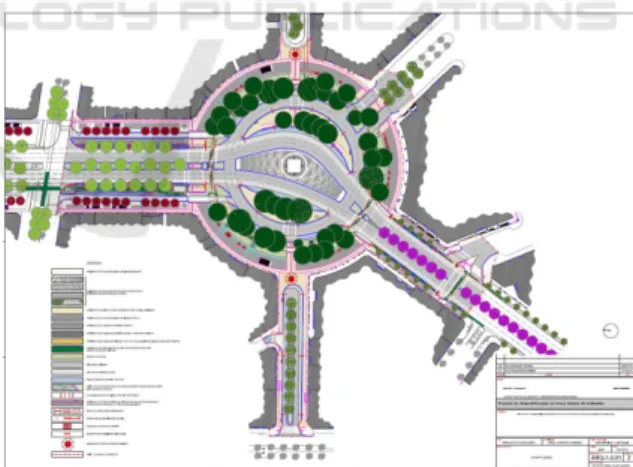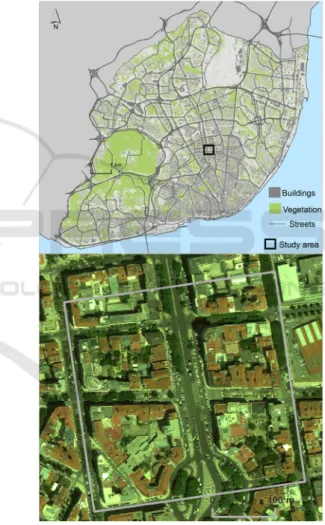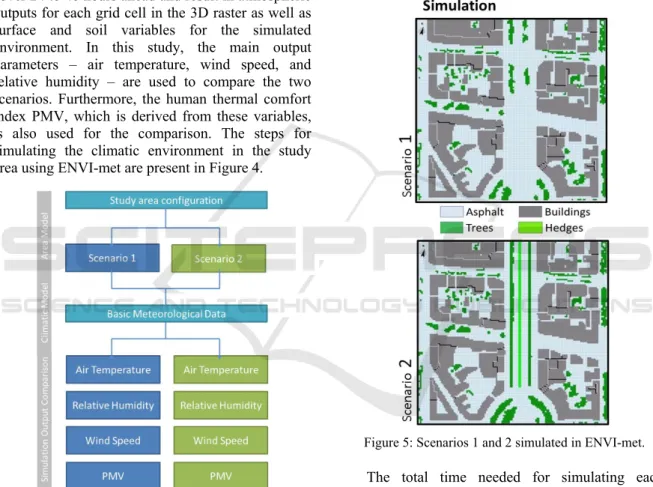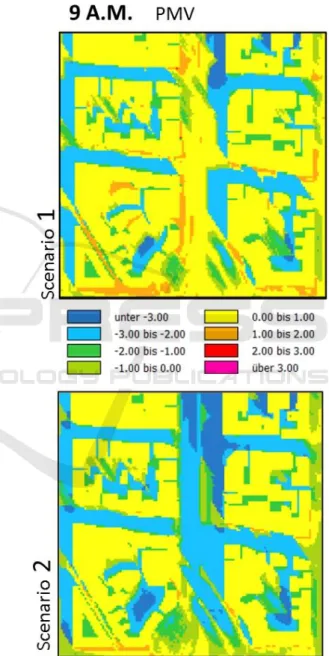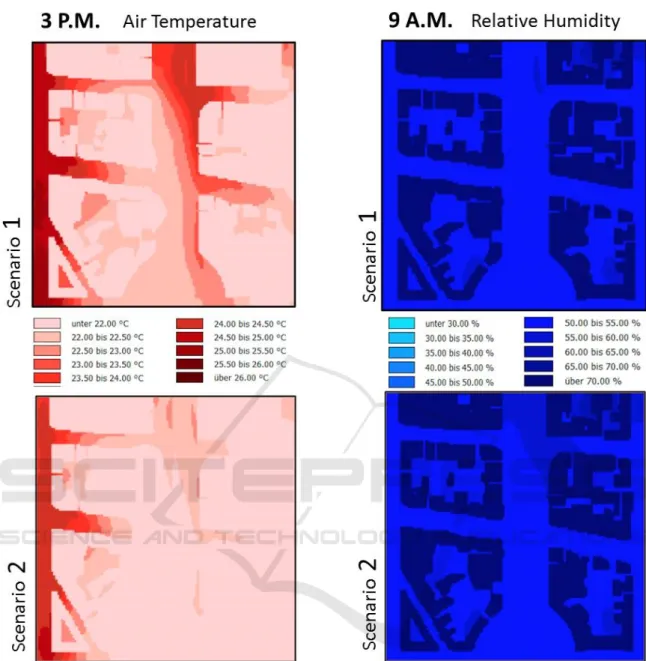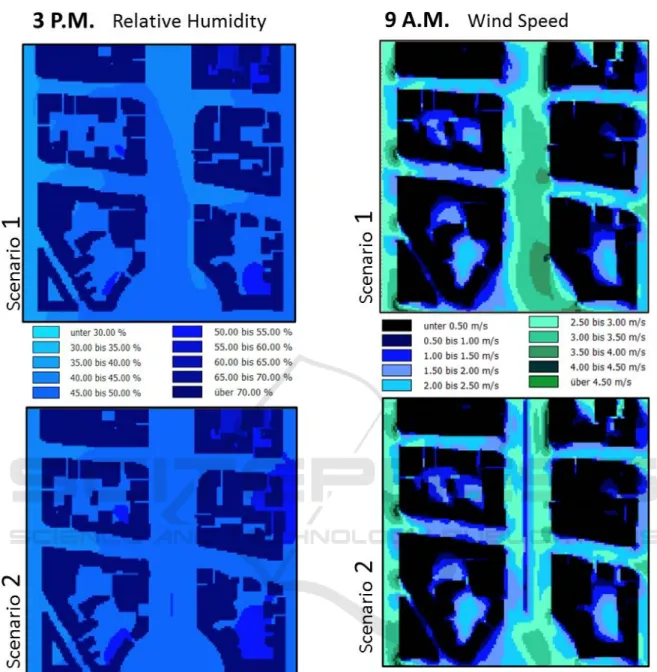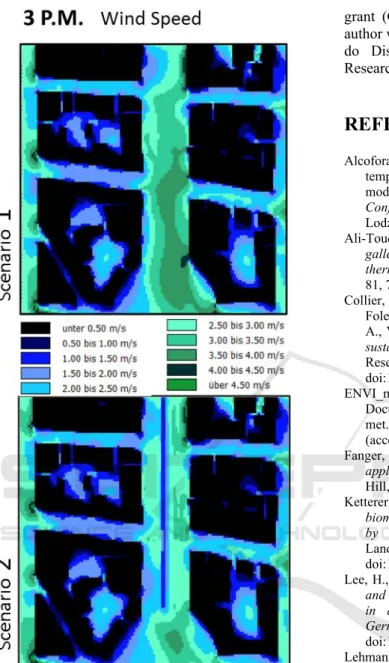Avenida Da República in Lisbon
Teresa Santos1, Caio Silva2 and José António Tenedório11Interdisciplinary Centre of Social Sciences (CICS.NOVA), Faculty of Social Sciences and Humanities (FCSH/NOVA),
Lisbon, Portugal
2Faculdade de Arquitetura e Urbanismo, Universidade de Brasília, Brasília, Brasil
Keywords: Thermal Comfort, ENVI-met, Urban Planning, Lisbon.
Abstract: In dense urban areas, reducing traffic and increasing green areas is foreseen as a way of promoting urban comfort. Using the urban requalification project for Lisbon’s Avenidas Novas neighbourhood as a case study, the effects of vegetation on microclimate and urban comfort are evaluated. In this context, the ENVI-met software is used to model the present and the future urban scenario. The simulation results indicate: i) increased urban comfort in the morning and in the afternoon resulting from the decrease in temperature due to the presence of new green areas foreseen by the urban project; ii) a reduction of up to 3 degrees in the morning (9h) and up to 3 degrees in the afternoon (15h); iii) the model implemented in ENVI-met suits the urban and environmental characteristics of Lisbon and it is, therefore, desirable that future urban rehabilitation projects should consider ex ante simulation of this type.
1 INTRODUCTION
The development of urban systems, in a context of climate change, requires adaption actions to mitigate emissions and increase public welfare. Local authorities are required to develop and implement strategies and actions to meet locally-adjusted sustainable development goals and targets, in alignment with existing planning frameworks and development priorities. In this context, urban interventions seeking to increase green areas are the key actions of the transformation of the city. Consequently, urban green space policy is increasingly being used as a tool to enhance urban resilience and sustainability (Collier et al., 2013).
Still, effective management for sustainable development requires reliable as well as evidence-based information on the potential effect of local programmes. In this context, geographical information based analysis can produce suitable data for understanding and monitoring the environmental effects of policy and program initiatives.
In 2016, the Lisbon City Hall has initiated the requalification of several public spaces within the city. One of these spaces is located in the central
area and foresees the substitution of traffic roads by new pedestrian zones and green areas. The goal is to provide the citizens with less noise, more spaces for walk, comfortable sidewalks, and lowered crosswalks for people with reduced mobility, more green areas, places for esplanades and bike lanes.
The increasing heat stress in cities represents a challenge for sustainable urban design (Lee et al., 2016). Promoting new green areas is a way of mitigating the Urban Heat Island (UHI) effect, since lower temperatures tend to occur in these places, than in sealed surfaces. In fact, vegetation contributes to the modification of urban climate by providing shading, evapotranspiration and channelling wind, either as a windbreak or as a wind funnel (Rosheidat et al., 2008).
Assessing the fine-scale thermal variation due to such changes in land cover within an urban environment is a way of quantifying the mitigation impact of green-space planning.
Ali-Toudert and Mayer (2007) used ENVI-met 3.0 to analyse the effect of vegetation on thermal comfort in urban street canyons located in Algerian Sahara. Using a selection of case studies including rows of trees with various crown densities and two
70
Santos, T., Silva, C. and Tenedório, J.
Modelling Urban Thermal Comfort: Evaluating the Impact of the Urban Requalification Project of Praça Duque De Saldanha and Avenida Da República in Lisbon. DOI: 10.5220/0006324500700080
wind incidences, parallel and perpendicular, the presence of vegetation along the canyons was found to affect the air temperature considerably. Air temperature in planted canyons was up to 1.5 ºC lower in comparison with unplanted streets with the same aspect ratio.
Oliveira et al., (2011) quantified the cooling effect of a small green space in the surrounding atmospheric environment of a densely urbanised area located in Lisbon, using local measures. The highest difference found was of 6.9 ºC in relation to the air temperature between shaded areas inside the garden and sunny areas located on the nearby street.
Ng et al., (2012) studied the cooling effects of greening in Hong Kong, using ENVI-met. They concluded that in highly density cities, a cooling effect of about 1 ºC is possible when tree coverage is larger than 1/3 of the total urban area.
Lehmann et al., (2014) analysed the micro-climate effect of urban vegetation structures in Dresden, Germany. The cooling effects ranged from 1 ºC to 2.1 ºC, according to the greenery provision.
Ketterer and Matzarakis (2014) studied the influence of green scenarios over the Physiologically Equivalent Temperature (PET), a thermal index based on the energy balance of the human body. PET, simulated by ENVI-met 3.5, was found to be around 10 ºC lower under trees compared with that over green areas and at least 25 ºC lower than that over sealed areas.
Locaro and Acero (2015) made a comparative analysis of green actions to improve outdoor thermal comfort inside urban street canyons, in Bilbao, Spain. The evaluation was performed in three typical urban street canyons characterized by different geometric proportions and five urban greenery scenarios in typical summer day conditions. Using ENVI-met v4.0, the greenery scenarios were analysed and results quantitatively confirm that the vegetation elements such as grass, green roofs and trees, improve the thermal comfort at pedestrian level. Furthermore, the highest PET reduction of 10 °C occurred by combining the presence of trees and grass.
Lee et al., (2016) tested the contribution of trees and grasslands to the mitigation of human heat stress in a residential district located in Southwest Germany. Using the ENVI-met model v.4, they concluded that trees are more effective in mitigating human heat stress than just grasslands.
The aim of this work is to evaluate the effect of replacing traffic roads by new trees and green areas as far as in the thermal comfort of the surrounding urban area are concerned.
The ENVI-met model was used in this study to simulate urban microclimate under two conditions: before and after site requalification.
2 STUDY AREA AND DATA BASE
Lisbon city occupies an area of 84 km2 and has
547733 inhabitants, according to the latest census (2011). The municipality is pursuing a strategy of urban regeneration by promoting the rehabilitation of vacant buildings and the qualitative improvement of public spaces, in particular enhancing green spaces and their connectivity.
2.1 Praça Duque De Saldanha and
Avenida Da República Project
One measure to face local urban climate challenges is to requalify typical neighbourhoods and squares. From a total of 150 squares, 30 were identified by the City Hall as priority within the framework of the program “A Square in Each Neighbourhood”. From this set, and in order to test the impact of the proposed layouts, the project of Praça Duque de
Saldanha and Avenida da República, was selected.
Due to software’s limitation regarding the area to be simulated; only a part of the project will be evaluated (Figures 1 and 2).
Figure 1: Praça Duque de Saldanha Project.
Several problems were identified and motivated urban intervention: 1) the discontinuity of tree alignments; 2) the use of the avenue as an express road which generates speed and insecurity in zebra crossings, sometimes resulting in fatal hitches; 3) the avenue’s road channel space, with 60 m wide, presents an irregular profile along its’ axis, mainly as a result of the successive interventions it was
subjected to from its initial conception to the present. Furthermore, the road axis presents
problems and inadequacies concerning the infrastructures for soft mobility. In fact, the sidewalks have variable widths, sometimes too small for walking, with physical obstacles and parking areas. The requalification of the public space was also motivated by the lack of cycling lanes and the disconnection with the network in operation and the projected one to the city. Given these considerations, the requalification project was designed with the intention of enhancing the scenic effect of the square (Praça Duque de Saldanha) in the avenue (Avenida
da República) and recovering the avenue’s initial
concept of “boulevard”.
Figure 2: Avenida da República Project - two first blocks.
Concerning the square’s requalification, the project proposes the following actions: 1) to reshape the traffic lanes in the roundabout; 2) to increase the pedestrian space near the buildings (11.80m), allowing areas for esplanades; 3) to make a wide green belt (12.50m) around the roundabout, separating the two urban functions (road and pedestrian); and 4) to eliminate parking spaces and to reallocate taxicab stops.
Regarding the avenue’s requalification, the project proposes the maintenance of the main road central axis. In the present-day, there are four lanes in one way and three in the opposite direction. In the project one of these central lanes will be eliminated and a new green central separator, 4 m wide is planned for the local. This corridor will have an alignment of trees and shrub vegetation, and parallel lanes will be replanted. Furthermore, parking spaces will be reduced, and cycling roads will be implemented. This new road design is expected to have an impact towards the reduction of the excessive speed of the vehicles, thus decreasing the chances for accidents.
2.2 Study
Area
The study area is located in Avenidas Novas
neighbourhood, where the commercial and tertiary activities take place.
The built environment includes a mix of apartment buildings and multi-storey commercial and mixed-used buildings. There are 146 buildings in the area, with a mean number of 6 floors. Higher buildings go up to 13 floors and include commercial areas located in the square.
The urban requalification project impact in the thermal comfort of the zone was evaluated in an area of 11.4 ha (Figure 3), including part of the square area and the two first blocks of Avenida da
República.
Figure 3: Study area located in Lisbon, Portugal.
2.3 Data
Base
In order to model the built environment before and after the urban requalification, a data base including planimetric, altimetric and meteorological data was compiled.
City Hall, allowed identifying which roads were to be eliminated and replaced by vegetation. Google maps’ satellite imagery was then used to model the buildings and the street level land cover before and after intervention.
To model the buildings’ height, a normalised Digital Surface Model (nDSM), with a resolution of 1 m2, obtained from a LiDAR flight in 2006, was
selected (Santos, 2011). To evaluate the cooling effects in the urban requalification project, a climatic characterisation of Lisbon city was performed (Table 1). Lisbon has a Mediterranean climate, with mild winters and hot and dry summers, classified as Csa according to the Köppen system. From the climatological normals of the period 1970-2000, August is the hottest month, with an average temperature of 22.5 ºC. For this month, the values of air temperature, wind speed and direction, and relative humidity at 2 m above ground were retrieved from www.portalclima.pt. The value for the roughness length was retrieved from Alcoforado and Lopes (2003), and the value for the specific humidity at model top, was retrieved from the
Wyoming University site (http://weather.uwyo.edu/upperair/sounding.html).
Table 1: Meteorological input parameters for summer time in Lisbon, Portugal.
Parameter Value Initial atmospheric temperature (K) 295.65
Wind speed measured at 10 m height (m/s) 4.27
Wind direction (deg) 315
Roughness length of study area (m) 1 Specific humidity at 2500 m (g/kg) 3.28
Relative humidity at 2 m (%) 62
3 METHODOLOGY
The assessment of the urban requalification project is evaluated using the ENVI-met free software (www.envi-met.com), version 3.1. The ENVI-met is a 3D microclimate model designed to simulate the surface-plant-air interactions in urban environment, at a microscale level (0.5-10 m in space, and 10 s in time). The main prognostic variables of the programme are wind speed and direction, air temperature and humidity, turbulence, radiative fluxes, bioclimatology and gas and particle dispersion. The software takes into account in the calculations, the radiation flux of short and long waves, and also the latent heat of vegetation and water elements. The ENVI-met was chosen due to the simplicity of the execution of the modeling
process. In addition, the program allows the generation of numerous types of scenarios and also the generation of spatialized results.
In a similar study, Lee et al. (2016) tested the ENVI-met v.4 and the RayMan software packages. They concluded that ENVI-met can deal with large numbers of tree canopies during the simulation process, unlike RayMan. Furthermore, RayMan could only investigate the micro-meteorological parameters at individual spots and, therefore, it was incapable of simulating spatial patterns of parameters such as mean radiant temperature (Tmrt)
and PET.
Among others, the ENVI-met model includes the calculation of biometrical indices like PMV (Predicted Mean Vote) that are used to measure and compare human thermal comfort in different environments. The PMV is based on the comfort model developed by Fanger (1972) and relates the energy balance of the human body with the human thermal impression using a straight empirical function. The calculation includes meteorological variables and personal settings. Using a biometeorological reference height of 1.6 m, the required variables include air temperature, mean radiant temperature, vapour pressure, and local wind speed. The personal settings include clothing insulation, mechanical energy production of the body and mechanical work factor. The PMV reference person is a 35 year old, male, with a height of 1.75 m and a weight of 75 kg (ENVI-met, 2016). The indicator scale ranges from -3 (very cold) to +3 (very hot), being 0 the thermal neutral value (i.e., comfort). PET will is not considered in this study, since the free ENVI-met v.3.1 does not deliver this index.
The ENVI-met model is designed in a 3D rectangular grid. In order to run area input file and a configuration file are required. The area input file includes information about the environment morphology, such as position and buildings’ height, plant type’s distribution, surface materials and soil types. The configuration file, on the other hand, includes simulation date and duration, as well as basic meteorological data.
Being a numerical model, the study area is reduced to grid cell and the user must manually introduce each element in the area. The visual background used to assist this modelling stage is an image from the study area, available in Google Maps. The buildings are the first elements to be modelled, including the location and the height of every element. For this task, the nDSM information is used. The second element to be modelled is
vegetation. For Scenario 1 – the present-day situation – the actual tree cover is modelled based on the visual interpretation of the image. For Scenario 2 – the projected situation – the urban requalification map is used to locate the future sidewalks, trees, and hedges. The soil and surface are the last elements to be modelled. In the study area, concrete and asphalt are the most common surfaces.After modelling the land cover of the study area, the basic meteorological framework for simulation must be defined (Table 1).The last step is to run the ENVI-met model. The ENVI-ENVI-met simulations typically cover 24 to 48 hours ahead and result in atmospheric outputs for each grid cell in the 3D raster as well as surface and soil variables for the simulated environment. In this study, the main output parameters – air temperature, wind speed, and relative humidity – are used to compare the two scenarios. Furthermore, the human thermal comfort index PMV, which is derived from these variables, is also used for the comparison. The steps for simulating the climatic environment in the study area using ENVI-met are present in Figure 4.
Figure 4: Methodological steps for climate modelling of the study area under two scenarios using ENVI-met.
4 RESULTS
AND
DISCUSSION
Two contrasting urban scenarios were modelled in order to assess the climatic impact of the proposed
Praça do Saldanha and Avenida da Républica urban
requalification project (Figure 5). Scenario 1 is the present-day situation, before requalification, and scenario 2 includes the site projected modifications
in order to increase the green area and sidewalks. In both scenarios the buildings occupy 35% of the area. In the first scenario, the vegetation cover is 12% of the area, while in the second scenario it is 38%. Furthermore, the sidewalks in the first scenario cover 13% of the area and 18% in the projected scenario. In both scenarios simulations were modelled under the same conditions: 1) the area input data was a 135x135x30 grid, 2) the grid cell size was dx=2.5, dy=2.5 and dz=2 m, and 3) Lisbon geographical position. The simulation duration was 24 hours.
Figure 5: Scenarios 1 and 2 simulated in ENVI-met.
The total time needed for simulating each scenario was about 30 hours. Table 2 shows the simulation results for booth scenarios.
Table 2: Simulation results for scenarios 1 (sc1) and 2 (sc2), in Lisbon, Portugal, during summer time.
Parameter 9 A.M. 3 P.M. sc1 sc2 sc1 sc2 Air temperature 21 oC 18 oC 25 oC 22 oC Relative humidity 50% 60% 35% 45% Wind speed 3.0 m/s 2.5 m/s 3.0 m/s 2.5 m/s PMV + 1 (slightly warm) - 1.5 + 1.5 (slightly - 1 cold)
The simulation process demonstrates an improvement in the comfort indexes for the morning and afternoon periods.
The PMV summarizes the effects of air temperature, radiation, humidity, and wind on the persons’ energy balance in one value each of it weighted with level of influence.
Observing the PMV maps, we can see that the warm periods are significantly reduced (Figures 6 and 7). In the morning, in scenario 1, the PMV indicates a slightly warm environment, while in the second scenario it indicates a slightly cold environment (Figure 6). In the afternoon period, there is also an inversion of the comfort assessments, going from slightly warm to a slightly cold environment (Figures 7).
Looking into the different meteorological parameters individually, the comparative results between the current scenario (1) and the projected one (scenario 2) show a great improvement in the comfort of the area. In fact, and regarding the air temperature, there is a reduction of up to 3 degrees in the morning (9 A.M) and in the afternoon (3 P.M) (Figures 8 and 9).
The reduction in air temperature can be explained by the presence of trees. Trees contribute to the reduction of the incoming solar radiation, which consequently reduces the mean radiant temperature. Nevertheless, this effect is more visible on the avenue, rather than on the square. This is due to the fact that, in the current scenario, trees are already present in the square area.
In what concerns to the relative humidity of the air, there was an increment of 10%. This fact can be attributed to the evaporation of the trees and lower vegetation (Figures 10 and 11).
Regarding natural ventilation, as expected, there is a slight reduction in natural ventilation in both morning and afternoon periods. In fact, wind speed decreases from 3.5 m/s to 2.5 m/s due to the barrier caused by the treetops, although ventilation is preserved at all times (Figure 12 and 13).
5 CONCLUSIONS
The results provided by the simulations allow comparing the effectiveness of the different scenarios. Through microclimate modelling, the potential improvements towards urban comfort resulting from an urban planning intervention in a square located in Lisbon are evaluated. .
Two scenarios were modelled, accounting for the land cover before and after the intervention. The
present-day situation – scenario 1 – includes 12% of the area with green cover (trees and shrubs), and the projected situation – scenario 2 – foresees an increment of 26%.
The simulation results indicate a clear improvement in the thermal comfort of the study area. Vegetation is, therefore, confirmed as a key element when designing comfort urban spaces.
Figure 6: PMV in Scenario 1 and Scenario 2 simulated in ENVI-met at 9 A.M.
Due to the model's pixel size, the details of the sidewalk and urban design are disregarded. However, it is clear that the new urban designs of the road with more sidewalk area and less area of
asphalt ensures an increase in thermal comfort, and contribute to the reduction of heat island formation. Furthermore, improving cycling and pedestrian conditions is also foreseen as a major contribution towards the citizens’ quality of life.
The ENVI-met demonstrates to be an efficient tool to evaluate present and future urban scenarios and to provide important information to support decision making. In fact, when considering alternative scenarios towards green cover, the contribution to mitigate the heat urban effect can and should be quantified.
Figure 7: PMV in Scenario 1 and Scenario 2 simulated in ENVI-met at 3 P.M.
Figure 8: Air temperature in Scenario 1 and Scenario 2 simulated in ENVI-met at 9 A.M.
Figure 9: Air temperature in Scenario 1 and Scenario 2 simulated in ENVI-met at 3 P.M.
Figure 10: Relative Humidity in Scenario 1 and Scenario 2 simulated in ENVI-met at 9 A.M.
Figure 11: Relative Humidity in Scenario 1 and Scenario 2 simulated in ENVI-met at 3P.M.
Figure 12: Wind speed in Scenario 1 and Scenario 2 simulated in ENVI-met at 9 A.M.
Figure 13: Wind speed in Scenario 1 and Scenario 2 simulated in ENVI-met at 3 P.M.
ACKNOWLEDGEMENTS
The authors would like to thank Logica the opportunity to use the LiDAR data set. This paper presents results partially supported by CICS.NOVA - Interdisciplinary Centre of Social Sciences of the Universidade Nova de Lisboa, UID/SOC/04647/2013, with the financial support of FCT/MCTES through National funds.
The first author was funded by the Fundação para a Ciência e Tecnologia, under a post-doctoral
grant (Grant SFRH/BPD/76893/2011). The second author was funded by Fundação de Apoio a Pesquisa do Distrito Federal do Brasil (Foundation for Research Support of DF).
REFERENCES
Alcoforado, M.-J., Lopes, A., 2003. Windfields and temperature patterns in Lisbon (Portugal) and their modification due to city growth. 5th International
Conference on Urban Climate (ICUC5), 383–386.
Lodz, Poland.
Ali-Toudert, F., Mayer, H., 2007. Effects of asymmetry,
galleries, overhanging façades and vegetation on thermal comfort in urban street canyons. Solar Energy
81, 742–754. doi:10.1016/j.solener.2006.10.007. Collier, M.J., Nedović-Budić, Z., Aerts, J., Connop, S.,
Foley, D., Foley, K., Newport, D., McQuaid, S., Slaev, A., Verburg, P., 2013. Transitioning to resilience and
sustainability in urban communities. Cities, Current
Research on Cities 32, Supplement 1, S21–S28. doi:10.1016/j.cities.2013.03.010.
ENVI_met. 2016. A holistic microclimate model [WWW Document], n.d. URL http://www.model.envi-met.com/hg2e/doku.php?id=apps:biomet_pmv (accessed 12.16.16).
Fanger, P., 1972. Thermal comfort analysis and
applications in environmental engineering.
Mcgraw-Hill, New York.
Ketterer, C., Matzarakis, A., 2014.
Human-biometeorological assessment of heat stress reduction by replanning measures in Stuttgart, Germany.
Landscape and Urban Planning 122, 78–88. doi:10.1016/j.landurbplan.2013.11.003.
Lee, H., Mayer, H., Chen, L., 2016. Contribution of trees
and grasslands to the mitigation of human heat stress in a residential district of Freiburg, Southwest Germany. Landscape and Urban Planning 148, 37–50.
doi:10.1016/j.landurbplan.2015.12.004.
Lehmann, I., Mathey, J., Rößler, S., Bräuer, A., Goldberg, V., 2014. Urban vegetation structure types as a
methodological approach for identifying ecosystem services – Application to the analysis of micro-climatic effects. Ecological Indicators 42, 58–72.
doi:10.1016/j.ecolind.2014.02.036.
Lobaccaro, G., Acero, J.A., 2015. Comparative analysis
of green actions to improve outdoor thermal comfort inside typical urban street canyons. Urban Climate,
Cooling Heat Islands 14, Part 2, 251–267. doi:10.1016/j.uclim.2015.10.002.
Ng, E., Chen, L., Wang, Y., Yuan, C., 2012. A study on the cooling effects of greening in a high-density city: An experience from Hong Kong. Building and Environment, International Workshop on Ventilation,
Comfort, and Health in Transport Vehicles 47, 256–
271. doi:10.1016/j.buildenv.2011.07.014.
Oliveira, S., Andrade, H., Vaz, T., 2011. The cooling
mitigation of urban heat: A case study in Lisbon.
Building and Environment 46, 2186–2194. doi:10.1016/j.buildenv.2011.04.034.
Rosheidat, A., Hoffman, D., Bryan, H. 2008. Visualizing Pedestrian Comfort Using Envi-Met, Third National
Conference of IBPSA-USA, 198–205. Berkeley,
California.
Santos, T., 2011. Producing Geographical Information for Land Planning using VHR Data: Local Scale Applications. LAP LAMBERT Academic Publishing.
